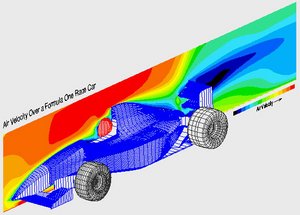Drag
For a solid object moving through a fluid or gas, drag is the sum of all the aerodynamic or hydrodynamic forces in the direction of the external fluid flow. It therefore acts to oppose the motion of the object, and in a powered vehicle it is overcome by thrust.
Types of drag are generally divided into three categories: parasitic drag, lift-induced drag and wave drag. Parasitic drag includes form drag, skin friction and interference drag. Lift-induced drag is only relevant when wings or a lifting body are present, and is therefore usually discussed only in the aviation perspective of drag. Beyond these two kinds of drag there is a third kind of drag, called wave drag, that occurs when the solid object is moving through the fluid at or near the speed of sound in that fluid. The overall drag of an object is characterized by a dimensionless number called the drag coefficient, and is calculated using the drag equation. Assuming a constant drag coefficient, drag will vary as the square of velocity. Thus, the resultant power needed to overcome this drag will vary as the cube of velocity.
Wind resistance is a layman's term used to describe drag. Its use it often vague, and is usually used in a relative sense (e.g. A badminton shuttlecock has more wind resistance than a squash ball).
